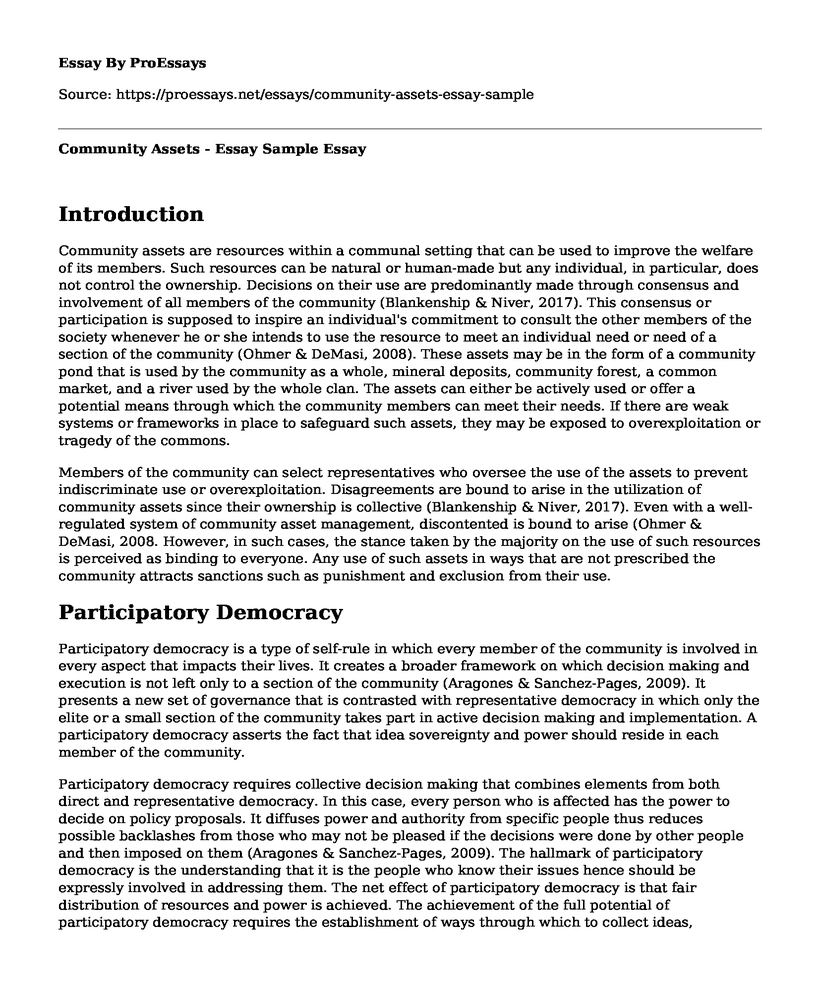Introduction
Community assets are resources within a communal setting that can be used to improve the welfare of its members. Such resources can be natural or human-made but any individual, in particular, does not control the ownership. Decisions on their use are predominantly made through consensus and involvement of all members of the community (Blankenship & Niver, 2017). This consensus or participation is supposed to inspire an individual's commitment to consult the other members of the society whenever he or she intends to use the resource to meet an individual need or need of a section of the community (Ohmer & DeMasi, 2008). These assets may be in the form of a community pond that is used by the community as a whole, mineral deposits, community forest, a common market, and a river used by the whole clan. The assets can either be actively used or offer a potential means through which the community members can meet their needs. If there are weak systems or frameworks in place to safeguard such assets, they may be exposed to overexploitation or tragedy of the commons.
Members of the community can select representatives who oversee the use of the assets to prevent indiscriminate use or overexploitation. Disagreements are bound to arise in the utilization of community assets since their ownership is collective (Blankenship & Niver, 2017). Even with a well-regulated system of community asset management, discontented is bound to arise (Ohmer & DeMasi, 2008. However, in such cases, the stance taken by the majority on the use of such resources is perceived as binding to everyone. Any use of such assets in ways that are not prescribed the community attracts sanctions such as punishment and exclusion from their use.
Participatory Democracy
Participatory democracy is a type of self-rule in which every member of the community is involved in every aspect that impacts their lives. It creates a broader framework on which decision making and execution is not left only to a section of the community (Aragones & Sanchez-Pages, 2009). It presents a new set of governance that is contrasted with representative democracy in which only the elite or a small section of the community takes part in active decision making and implementation. A participatory democracy asserts the fact that idea sovereignty and power should reside in each member of the community.
Participatory democracy requires collective decision making that combines elements from both direct and representative democracy. In this case, every person who is affected has the power to decide on policy proposals. It diffuses power and authority from specific people thus reduces possible backlashes from those who may not be pleased if the decisions were done by other people and then imposed on them (Aragones & Sanchez-Pages, 2009). The hallmark of participatory democracy is the understanding that it is the people who know their issues hence should be expressly involved in addressing them. The net effect of participatory democracy is that fair distribution of resources and power is achieved. The achievement of the full potential of participatory democracy requires the establishment of ways through which to collect ideas, concerns, opinions, and reservations of the people about a particular issue (Aragones & Sanchez-Pages, 2009). Such information is then factored into the final decision. Participatory democracy, therefore, emphasizes equality, social inclusion, and protection of autonomy, transparency, and accountability.
References
Aragones, E., & Sanchez-Pages, S. (2009). A theory of participatory democracy based on the real case of Porto Alegre. European Economic Review, 53(1), 56-72. Doi: 10.1016/j.euroecorev.2008.09.006.
Blankenship, L. A., & Niver, H. M. (2017). What Are Community Resources? Chicago, IL: Britannica Educational Publishing.
Ohmer, M. L., & DeMasi, K. (2008). Consensus organizing: A community development workbook: a comprehensive guide to designing, implementing, and evaluating community change initiatives. Thousand Oaks: SAGE Publications.
Cite this page
Community Assets - Essay Sample . (2022, Dec 12). Retrieved from https://proessays.net/essays/community-assets-essay-sample
If you are the original author of this essay and no longer wish to have it published on the ProEssays website, please click below to request its removal:
- Stereotyping of Masculinity - Term Paper Example
- The School and Community Relations
- Paper Example on Independent, Dependent, and Intervening Variables
- Policy-Factors That Impact the Academic Success of College Students Essay
- Essay Sample on Cultural Adaptation: How Puerto Rican Society Evolves
- African Americans: Struggling Against Discrimination and Inequality - Research Paper
- Essay Sample on Unifying Communities: The Power of Rhetorical Appeals







